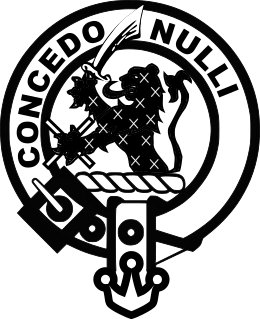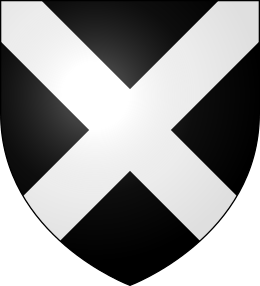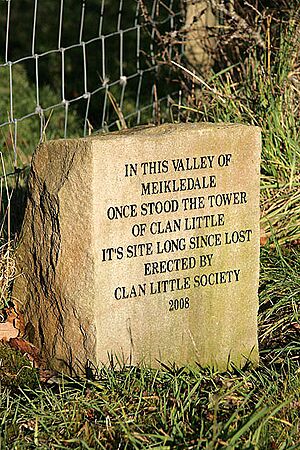Clan Little facts for kids
Clan Little is a historic Scottish clan from the Borders region of Scotland. A clan is like a large family group with shared history and traditions. Today, Clan Little does not have a recognized leader, called a chief. Because of this, it is known as an armigerous clan. This means the clan has a coat of arms but no chief to represent it. The Clan Little Society once had a Guardian, who acted like a chief. However, since his passing in 2007, a new leader has not yet been found.
Quick facts for kids Clan Little |
|
|---|---|

Crest: A demi lion Sable powdered with saltires Argent, armed Gules, in dexter paw a cutlass Proper and in sinister a saltire Argent
|
|
| Motto | Concedo nulli or Fidei coticula crux |
| Profile | |
| Region | Borders |
 |
|
| Clan Little has no chief, and is an armigerous clan | |
| Historic seat | Meikledale |
| Last Chief | Little of Meikledale |
Contents
History of Clan Little
Where the Little Name Came From
The name "Little" comes from a descriptive word. In old Latin documents, it was written as parvus. This word means "little" or "small." Because it's a descriptive name, it's hard to find one exact starting point for the Little name in Scotland.
In the 1100s, King David I of Scotland appointed Walter fitz Alan as High Steward. Walter was from Shropshire, England. As Steward, he gave land in Cairntable, Ayrshire, to Alan Little. Alan was a former neighbor from the Shropshire-Cheshire border. By the 1300s, the Littles had settled in Dumfriesshire. Nicol Little was recorded there as a peacekeeper in the Scottish West March. This was a border area with England.
Around 1426, Simon Lytil received land in Ewesdale, Dumfriesshire. This grant was given by the regent, Robert Stewart, 1st Duke of Albany. It was confirmed in 1426 after King James I returned from England. Simon Little, the first Laird of Meikledale, is seen as the first chief of the clan.
In 1587, the Scottish Parliament made a law. It aimed to control the "disorderly subjects" living in the Borders and Highlands. A list of family names was attached to this law. The Borders part listed 17 "clans" with a chief. Clan Little was listed as a clan of the West March.
Clan Little and William Wallace
Around the time Alan Little got his land, Walter the Steward gave land near Kilmarnock to Richard le Waleys. Richard was the great-great-grandfather of Sir William Wallace. Wallace was a famous leader in the early Wars of Scottish Independence.
It is believed that William Wallace's sister might have married a Little. They may have had a son named Edward. Edward became a trusted helper to Wallace. The old poem The Wallace mentions him. It says: "And Edward Littil his sisters sone so der / Full wel graithit in till thar armour cler." This suggests a close family tie.
The 1400s and Clan Little
Members of the Little clan became well-known in Ewesdale, Eskdale, and Wauchopedale. After the House of Douglas lost their lands in 1455, the Eskdale-Ewesdale areas went to the Maxwell clan. However, the homes of the Littles at Meikledale and the Elliots at Arkelton were not affected. These lands were not feudal property.
The 1500s and Border Reivers
By the early 1500s, Clan Armstrong had become very powerful. It was said that in 1528, they could gather 3,000 horsemen. Many Littles were among them. Their leader, Johnnie Armstrong of Gilnockie, was seen as a threat by King James V.
In 1530, the King arranged to meet Johnnie at Caerlanrig. The Armstrong group was surprised by the king's men. Then, 33 Armstrongs, Littles, Elliots, and Irvings were put to death there. Johnnie Armstrong was among them.
In 1568, over 100 Littles rode with other clans. They joined John Maxwell, 8th Lord Maxwell on a raid to Stirling. Family stories say the Littles returned with many more horses than they started with. They were later pardoned in 1585.
The 1600s and the Union of Crowns
When James I of England and VI of Scots became king of both England and Scotland in 1603, he no longer needed strong men in the Border areas. The Border reivers (who were like armed raiders) had become a problem for the king. Efforts were made to stop them using force. Many Borderers were sent to Ireland. Others moved to north-west Cumberland. At this time, Simon Little of Meikledale was chief. His son Thomas, and grandson David, followed him. David was chief in 1670.
The 1700s and Migration
David Little was the last Little to be the Laird of Meikledale. After the Borders became peaceful, the land passed to Thomas Beattie. David was given a job as a groom at Windsor Castle. He had two sons: Simon Little of Nittyholm, who had seven daughters, and Matthew (or William?) Little. Matthew lived in Reading and "went to sea" in 1745. His descendants have not yet been found.
Throughout the 1700s and 1800s, Littles moved to many places. They went across the United Kingdom. They also traveled to North America, Australia, South Africa, and New Zealand.
Clan Symbols
Clan Arms
The arms of the Lairds of Meikledale were simple. They were sable a saltire argent, which means a silver X shape on a black background. Sometimes they were sable a saltire engrailed argent, meaning the X shape had wavy edges.
In 1997, the Clan Little Society received a new Grant of Arms. This was from the Lord Lyon King of Arms, Scotland's official in charge of heraldry. The new design is: sable a saltire argent in chief point a winged stirrup or on a chief or four chain links fesswise gules. This means a silver X on black, with a golden winged stirrup at the top. Above that, on a golden band, are four red chain links.
Crest Badge
The Clan Crest badge is made from the last chief's heraldic crest and motto.
- Meikledale's mottoes are: Concedo nulli or Fidei coticula crux.
- Meikledale's crest is: A demi lion Sable powdered with saltires Argent, armed Gules, in dexter paw a cutlass Proper and in sinister a saltire Argent. This describes a black half-lion with silver X's, red claws, holding a sword in one paw and a silver X in the other.
Clan Mottoes
Here are the mottoes associated with Clan Little and what they mean:
- Concedo Nulli – This means "I yield to none."
- Magnum in Parvo – This means "Great in little."
- Fidei Coticula Crux – This means "The cross is the test of truth."
Clan Tartan
Members of the Clan Little Society can wear the Little of Morton Rigg tartan. A tartan is a patterned cloth, often associated with Scottish clans. This particular pattern was created in 1991 by Dr. James "Johnnie" Crawford Little. He was the clan guardian at the time.
The tartan includes parts of the Wallace tartan. This is a nod to the historical link with Sir William Wallace. It also includes parts of the Shepherd tartan. In the 1800s, Littles and other Borderers often wore simple black and white checked Border tartan. They might also wear European clothing. Unlike national Scottish Dress rules, Border clansmen sometimes wore different tartans together. For example, it's okay to wear trousers in the Little of Morton Rigg tartan. You can also wear a maud (plaid) (a large plaid shawl) in Border tartan.
Livery Colours
The livery colours for Clan Little are black and white. These colours come from the arms of the Lairds of Meikledale.
Clan Plant
The clan plant for Clan Little is Heather.
Clan March
The clan march is a piece of music called The Reivers of Meikledale. It is a 2/4 march. John Mason MBE wrote this music for the clan in 1993. You can find the music in the February 2013 edition of the Sprig of Heather - Clan Little Newsletter.
See also
- Little (surname)


